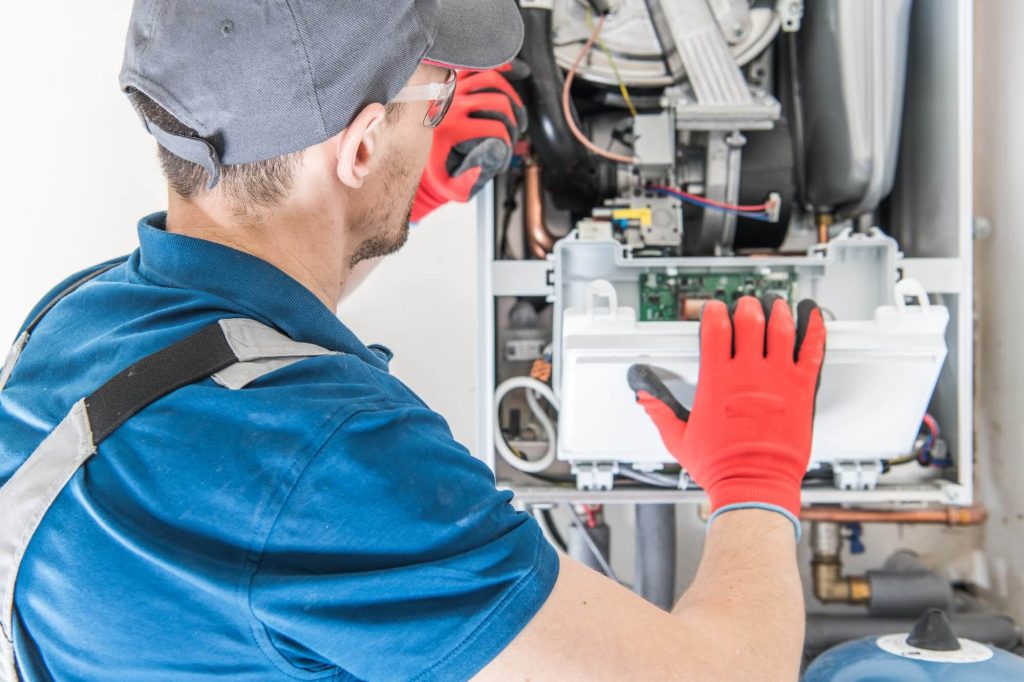When it comes to selecting the right furnace for your home, you’ll often hear the terms “downflow” and “upflow.” These terms refer to how the furnace distributes warm air throughout your home.
Understanding the key differences between these two types of furnaces and knowing how to choose the best option for your specific needs can save you money, enhance comfort, and improve energy efficiency. For a deeper dive into choosing the right furnace, check out our comprehensive Furnace Buyer’s Guide.
For a deeper dive into choosing the right furnace, check out our comprehensive Furnace Buyer’s Guide.

What Is a Downflow Furnace?
A downflow furnace pushes warm air downward into your home’s duct system. It is typically installed in homes where the ductwork is located beneath the main living space, such as in homes with basements or crawl spaces.
Key Features of a Downflow Furnace:
- Air Distribution: Heated air flows down through the furnace and into ducts below the unit.
- Ideal Placement: Commonly installed in attics or on the main floor when ducts are located in a basement or crawl space.
- Typical Use Case: Suitable for homes in warmer climates where heating needs are less frequent, or for homes with space constraints that require attic installation.
Pros of Downflow Furnaces:
- Great for homes where ductwork is under the floor.
- Can maximize space efficiency in certain home layouts.
- Easy to access for maintenance when installed in an attic.
Cons of Downflow Furnaces:
- Installation can be more complex and expensive in some cases.
- Warm air may take longer to heat lower floors effectively.
What Is an Upflow Furnace?
An upflow furnace pushes warm air upward into your home’s duct system. These furnaces are typically installed in basements or crawl spaces where the ductwork is located above the furnace.
Key Features of an Upflow Furnace:
- Air Distribution: Heated air flows upward through the furnace and into ducts above the unit.
- Ideal Placement: Commonly installed in basements or utility rooms where ducts are located overhead.
- Typical Use Case: Ideal for homes in colder climates where heating is a priority.
Pros of Upflow Furnaces:
- Provides faster and more efficient heating for upper floors.
- Generally easier to install when ductwork is located overhead.
- Can offer higher energy efficiency for homes in colder regions.
Cons of Upflow Furnaces:
- Requires sufficient space in a basement or utility room for installation.
- Not suitable for homes without overhead ductwork.
Key Differences Between Downflow and Upflow Furnaces
| Feature | Downflow Furnace | Upflow Furnace |
| Airflow Direction | Pushes warm air downward | Pushes warm air upward |
| Ideal Placement | Attics or main floors with ducts below | Basements or crawl spaces with ducts above |
| Efficiency | May lose some efficiency in colder climates | Highly efficient in colder climates |
| Heating Speed | Slower heating for lower floors | Faster heating for upper floors |
| Installation Cost | Can be more expensive if ducts aren’t nearby | Typically less costly in existing setups |
Factors to Consider When Choosing the Best Option
When deciding between a downflow and upflow furnace, consider the following factors:
1. Home Layout
The placement of your ductwork plays a significant role in determining which furnace type is best. If your ducts are below the living space, a downflow furnace is the logical choice. Conversely, if your ducts are above the living space, an upflow furnace is more practical.
2. Climate
If you live in a colder climate, an upflow furnace is typically more efficient because warm air naturally rises. On the other hand, a downflow furnace can work well in milder climates where heating needs are less demanding.
3. Space Availability
The available space for installation can also influence your decision. Upflow furnaces often require more space in basements or utility rooms, while downflow furnaces are suited for attics or main floors with limited space.
4. Energy Efficiency
Energy-efficient furnaces can save you money on utility bills. Many modern furnaces, whether upflow or downflow, come with high-efficiency ratings, but their performance may vary based on your home’s layout and insulation.
5. Installation Costs
The cost of installation depends on the complexity of the setup. Downflow furnaces may require additional ductwork modifications if installed in a home with overhead ducts, which can increase costs.

Here are some steps to help you choose the best furnace for your home:
- Consult a Professional HVAC Technician: An HVAC technician can evaluate your home’s layout, ductwork, and heating needs to recommend the best option.
- Consider Long-Term Costs: Factor in both the initial installation cost and long-term energy savings when making your decision.
- Think About Future Upgrades: If you’re planning a renovation, consider whether your heating system can adapt to changes in your home’s layout.
- Evaluate Your Climate: Choose a furnace that can efficiently meet your heating demands based on your local weather conditions.
If you’re also exploring other heating systems, our detailed comparison of Boilers vs. Furnaces can help you decide which option is right for your home.
Expert Furnace Solutions with HVAC Near Me
Both downflow and upflow furnaces offer unique advantages depending on your home’s design, climate, and heating needs. Understanding the key differences and carefully considering your specific requirements will help you make an informed decision. By choosing the right furnace, you can ensure a comfortable and energy-efficient home for years to come.
For expert advice and professional HVAC services, trust HVAC Near Me. Whether you need to buy a new furnace, furnace repair, furnace maintenance, or guidance on the best heating system for your home, we’re here to help.

